|





|
|
 Jean-Paul
MARAT's destiny Jean-Paul
MARAT's destiny
Charlotte Corday
(July 27th,1768/July
17th,1793), aristocrat with no
wealth, French patriot, was born in Les Champeaux, a
hamlet about five kilometers from Vimoutiers.
Descended from the dramatist Pierre Corneille, on her mother line, adept of the
philosophs Plutarch,
Tacitus and
Rousseau, sympathizer of the moderates, or
Girondists, during the
French Revolution, she determined to kill
Jean-Paul Marat,
Montagnard and radical
Jacobins, whom she held responsible for the
Reign of Terror. Charlotte went to Paris, she gained
admittance to Marat's house on the pretext of disclosing to him the
names of Girondins in the city of Caen. Marat suffering of skin
problems, used to work in a bath. Charlotte is admitted in the room,
and here stabbed him to death while he was in his bath. Charlotte was
captured by Marat's friends before she could escape, and condemned by
the revolutionary tribunal.
►
The childhood
►
The exaltation
►
The murder
►
In jail, the trial
►
The guillotine
►
Videos/CLIP/film
►
Historical background
|
|
L'abbaye aux Dames
à Caen
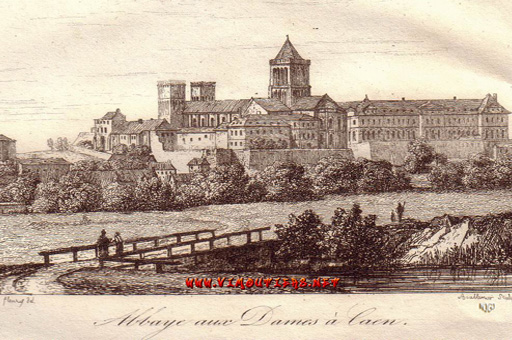
After her mother's death, from 1782 to 1791 Charlotte was educated in the
Abbaye aux Dames, a convent in Caen, founded in 1060 by Matilda of Flander,
William of Normandy/the Conqueror's spouse. She received the education given to girls of the nobility then in the last three years, worked as a "secretary".
Charlotte and her sister, with the help of Father Gombault, former priest of the family, had been admitted in the convent as boarder of "nobility penniless" against subsidy.
►
L'Abbaye aux Dames nowadays
|
148, rue Saint-Jean, Caen
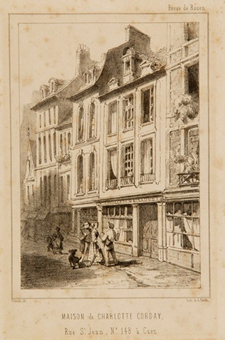
But then, convents were closed ... French Revolution,
church properties placed "at the disposal of the Nation" ... and Charlotte, after a short stay in la Ferme des Bois, Le Menil-Imbert, where her father were living, retired in 1791 at an old
aunt's, Madame Coutellier de Bretteville, 148 rue Saint-Jean in Caen, with whom she would share a secluded life.
Le Grand Manoir (destroyed circa 1850), litho de A.Peron sur publication de Ch Vatel, 1872,
musée Pierre Corneille.
|
Maison dite "de Charlote Corday" rue Saint-Jean, Caen
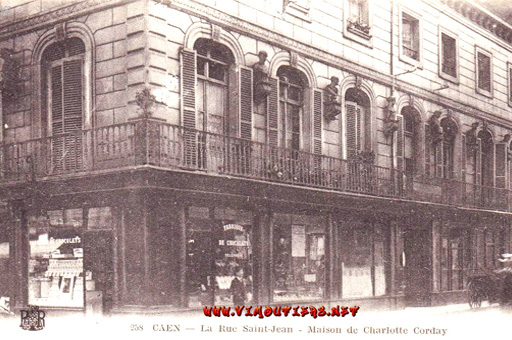
Her numerous readings inspired Charlotte with republican
ideologies. She met in l'Hôtel de l'Intendance* a few Girondists,
sheltered in the city after the victory of the Montagnards -May & June 1793-
who, in majority at National Convention, were imposing the
Reign of Terror.
Charlotte, thenceforth conceived the idea of helping the Girondins ...
(built after 1850, 148 rue Saint-Jean, destroyed by the bombings in 1944).
*
►
Soulèvement de Caen contre la Convention Nationale
|
|
A Caen ...
Reading exalts her imagination ...
Louis XVI, guillotined in Paris January 21, 1793 ...
L'abbé Gombault, whom she was very close, brutally guillotined in Caen April 5, 1793 ...
The terror and its murders increasing ...
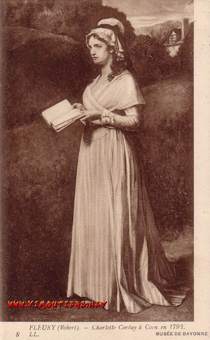
... Charlotte assigned full responsibility to Marat, Montagnard, Paris deputy at the National Convention.
She considered him as the main instigator of the Massacres, "a wild beast who was about to devour France with the fire of civil war".
And it was the courage of the inhabitants of Caen, initially reluctant to volunteer in the fight against the Convention, which decided her to go to Paris,
according to what she explained in a letter to Congressman Charles Jean Marie Barbaroux.
|
In Charlotte's steps
|
Auberge de Lisieux
In July 1793, then definitely convinced that Marat is responsible, Charlotte decided to go to Paris in order to kill him.
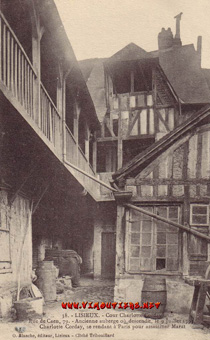
She took the stagecoach and stopped at l'auberge du Dauphin, in Lisieux on the 9th of
July ...(destroyed by the bombings in 1944)
With humor, she told the story of her journey at the beginning of the letter she wrote in prison to Barbaroux.
... >>> Charlotte Corday next :
1
/
2
/
3
/
4
/
5
|
|
Charlotte's
Baptism record :
"Ce
vingt-huit de juillet mil sept cent soixante-huit, par nous
soussigné curé, a été
baptisée Marie-Anne-Charlotte née d'hier du
légitime mariage de messire Jacques-François de
Corday, écuyer, seigneur d'Armont et de noble dame
Marie-Jacqueline de Gautier, son épouse, de cette paroisse;
le parrain, messire Jean-Baptiste-Alexis de Gautier, écuyer,
seigneur de Mesnival; la marraine, noble dame
Françoise-Marie-Anne Levailant de Corday; le père
présent.
Ont signé : Levaillant de Corday, de Gautier de Mesnival,
Corday d'Armont, J.L. Pollard, curé des Ligneries"
The above transcription is the one which was given
to Charlotte for her admittance in the Ladies's Abbey in Caen in 1782.
Her
parents were Jacques-François de Corday and Marie-Jacqueline
de Gautier,
Her
godfather was Baptiste-Alexis de Gautier, her godmother was
Françoise-Marie-Anne Levailant de Corday.
|
|